Coordinate regulation of cadherin and integrin function by the chondroitin sulfate proteoglycan neurocan
- PMID: 10851024
- PMCID: PMC2175121
- DOI: 10.1083/jcb.149.6.1275
Coordinate regulation of cadherin and integrin function by the chondroitin sulfate proteoglycan neurocan
Abstract
N-cadherin and beta1-integrins play decisive roles in morphogenesis and neurite extension and are often present on the same cell. Therefore, the function of these two types of adhesion systems must be coordinated in time and space to achieve the appropriate cell and tissue organization. We now show that interaction of the chondroitin sulfate proteoglycan neurocan with its GalNAcPTase receptor coordinately inhibits both N-cadherin- and beta1-integrin-mediated adhesion and neurite outgrowth. Furthermore, the inhibitory activity is localized to an NH(2)-terminal fragment of neurocan containing an Ig loop and an HA-binding domain. The effect of neurocan on beta1-integrin function is dependent on a signal originating from the cadherin cytoplasmic domain, possibly mediated by the nonreceptor protein tyrosine kinase Fer, indicating that cadherin and integrin engage in direct cross-talk. In the developing chick, neural retina neurocan is present in the inner plexiform layer from day 7 on, and the GalNAcPTase receptor becomes restricted to the inner nuclear layer and the ganglion cell layer (as well as the fiber layer), the two forming a sandwich. These data suggest that the coordinate inhibition of cadherin and integrin function on interaction of neurocan with its receptor may prevent cell and neurite migration across boundaries.
Figures
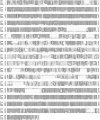


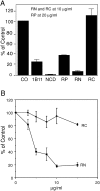
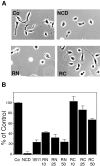

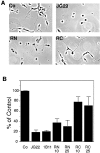
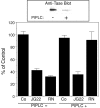

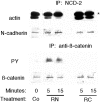


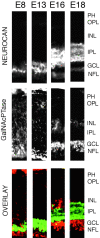



Similar articles
-
The nonreceptor tyrosine kinase fer mediates cross-talk between N-cadherin and beta1-integrins.J Cell Biol. 2000 Jun 12;149(6):1263-74. doi: 10.1083/jcb.149.6.1263. J Cell Biol. 2000. PMID: 10851023 Free PMC article.
-
The neuronal chondroitin sulfate proteoglycan neurocan binds to the neural cell adhesion molecules Ng-CAM/L1/NILE and N-CAM, and inhibits neuronal adhesion and neurite outgrowth.J Cell Biol. 1994 May;125(3):669-80. doi: 10.1083/jcb.125.3.669. J Cell Biol. 1994. PMID: 7513709 Free PMC article.
-
The juxtamembrane domain of cadherin regulates integrin-mediated adhesion and neurite outgrowth.J Neurosci Res. 1999 Dec 15;58(6):727-34. doi: 10.1002/(sici)1097-4547(19991215)58:6<727::aid-jnr1>3.0.co;2-7. J Neurosci Res. 1999. PMID: 10583905 Review.
-
The interaction of the retina cell surface N-acetylgalactosaminylphosphotransferase with an endogenous proteoglycan ligand results in inhibition of cadherin-mediated adhesion.J Cell Biol. 1995 Jun;129(5):1391-401. doi: 10.1083/jcb.129.5.1391. J Cell Biol. 1995. PMID: 7775582 Free PMC article.
-
beta-Catenin is a target for extracellular signals controlling cadherin function: the neurocan-GalNAcPTase connection.Curr Top Dev Biol. 1997;35:161-89. doi: 10.1016/s0070-2153(08)60259-8. Curr Top Dev Biol. 1997. PMID: 9292270 Review. No abstract available.
Cited by
-
Chondroitin sulfate effects on neural stem cell differentiation.In Vitro Cell Dev Biol Anim. 2016 Jan;52(1):35-44. doi: 10.1007/s11626-015-9941-8. Epub 2015 Aug 19. In Vitro Cell Dev Biol Anim. 2016. PMID: 26288008
-
Cadherin-8 and N-cadherin differentially regulate pre- and postsynaptic development of the hippocampal mossy fiber pathway.Hippocampus. 2008;18(4):349-63. doi: 10.1002/hipo.20395. Hippocampus. 2008. PMID: 18064706 Free PMC article.
-
The proteoglycan brevican binds to fibronectin after proteolytic cleavage and promotes glioma cell motility.J Biol Chem. 2008 Sep 5;283(36):24848-59. doi: 10.1074/jbc.M801433200. Epub 2008 Jul 7. J Biol Chem. 2008. PMID: 18611854 Free PMC article.
-
Identification of tyrosine-phosphorylated proteins associated with metastasis and functional analysis of FER in human hepatocellular carcinoma cells.BMC Cancer. 2009 Oct 16;9:366. doi: 10.1186/1471-2407-9-366. BMC Cancer. 2009. PMID: 19835603 Free PMC article.
-
Upregulation of CSPG3 accompanies neuronal progenitor proliferation and migration in EAE.J Mol Neurosci. 2011 Mar;43(3):531-40. doi: 10.1007/s12031-010-9476-0. Epub 2010 Nov 25. J Mol Neurosci. 2011. PMID: 21107918
References
-
- Balsamo J., Lilien J. N-cadherin is stably associated with, and is an acceptor for, a cell surface N-acetylgalactosaminylphosphotransferase. J. Biol. Chem. 1990;265:2923–2928. - PubMed
-
- Balsamo J., Lilien J. The retina cell-surface N-acetylgalactosaminylphosphotransferase is anchored by a glycophosphatidylinositol. Biochemistry. 1993;32:8246–8250. - PubMed
-
- Balsamo J., Hoffman S., Lilien J. Control of cadherin-mediated cell-cell adhesion through regulated association with the cytoskeleton. J. Braz. Assoc. Adv. Sci. 1996;48:341–346.
Publication types
MeSH terms
Substances
Associated data
- Actions
Grants and funding
LinkOut - more resources
Full Text Sources
Other Literature Sources
Molecular Biology Databases
Research Materials
Miscellaneous

